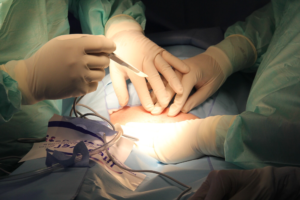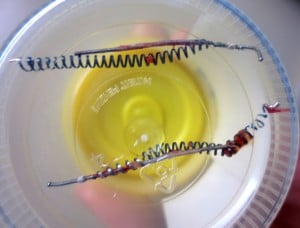 If you were looking into sterilization procedure options between 2002 and 2018, you may have heard about Essure. This non-hormonal sterilization device was thought to be a great, non-invasive way for patients to permanently prevent pregnancy. Essure was heavily marketed as a ‘non-surgical’ option for a tubal ligation.
If you were looking into sterilization procedure options between 2002 and 2018, you may have heard about Essure. This non-hormonal sterilization device was thought to be a great, non-invasive way for patients to permanently prevent pregnancy. Essure was heavily marketed as a ‘non-surgical’ option for a tubal ligation.
Non-surgical means no problems…right? Wrong!
Some women began having problems soon after the devices were inserted.
If you received an Essure implant and now you’re experiencing negative symptoms, you can get the device removed.
Read on to learn more about Essure removal and what to expect from the procedure.
What Is Essure?
Before we dive into all the specifics of Essure removal, let’s talk a little more about what Essure is. Essure was a birth control device that was approved by the FDA in 2002. This device was non-hormonal and permanent. All that was needed was a simple little office procedure to have the devices inserted inside the fallopian tubes.
Essure consisted of two small coils made of a body-safe plastic that could be inserted without surgery. Doctors would insert these coils through the vagina and into the fallopian tubes. Over time, the patient’s body would grow tissue around these coils, permanently blocking off the fallopian tubes.
Side Effects of Essure
While Essure seemed like a miracle device at first, patients soon started reporting very serious side effects of the device. Thousands of patients started suffering from severe abdominal pain, while others found that their periods were much heavier than they used to be. Many people suffered headaches, fatigue, weight fluctuations, and rashes.
More alarmingly, many patients found that the device broke and there were fragments lodged in various places in their bodies. There were reports of perforations, devices migrating to other parts of the body, or the device getting lodged in the wrong position or coming loose. There have been twenty-three adult deaths reported as a result of Essure, as well as thousands of reports of pain, abnormal bleeding, and pregnancy losses.
Essure Discontinued
Within a decade, it became apparent that Essure was not behaving as it was designed to and was too risky to keep it on the market. In 2018, Bayer, the company that manufactured Essure, discontinued the product in the United States. The product had already been discontinued in every other country two years before.
After they discontinued Essure, Bayer worked with the FDA throughout 2019 to conduct a massive recall of all unused products. This campaign was so successful that as of this writing, there are just ten known unused Essure devices still floating around. The FDA is still continuing to conduct a long-term study on Essure patients to figure out what the long-term effects of this device might be.
Diagnosing Essure Problems
If you got an Essure device and you’re now experiencing any of the symptoms we discussed, the first thing you need to do is to go speak to your doctor. There’s a reasonable chance that you may be one of the thousands of people experiencing problems with this device. But your doctor will need to rule out any other underlying causes, as all of the symptoms we mentioned can be the result of other conditions.
It’s best to work with a doctor who has experience working with Essure problems if possible. Many doctors may not be familiar with this device and the wide-ranging symptoms it can cause. And in our medical system, women’s pain tends to be ignored and undertreated anyhow, making it even more challenging for patients to get a diagnosis.
Benefits of Essure Removal
Of course, the biggest benefit of getting your Essure device removed is that there’s a chance your symptoms may improve after you get the device taken out. As we’ll discuss later, this doesn’t happen for everyone, but it may be one of the best first steps you can take. This may be particularly effective if you’re experiencing pain, depression, or weight fluctuations.
However, even if you aren’t experiencing these symptoms, you might want to talk to your doctor about getting Essure removed. The FDA does say that patients who have Essure but aren’t experiencing any negative side effects should be safe keeping the device in. However, having Essure removed can give you peace of mind that the device won’t start causing problems down the road.
Exam Before Removal
Before you schedule your Essure removal, you’ll need to set up an exam with your doctor. After your doctor runs any tests they need to in order to rule out other causes, they’ll have to do an ultrasound. This will give them an idea of where your Essure device is and what condition it’s in before your operation.
You and your doctor will also need to discuss the best option for how to remove your Essure device. The options will vary depending on your age, the status of your Essure device, and several other factors. As we’ll discuss later, if you hope to get pregnant after the removal of your Essure device, you may want to consider Essure reversal, rather than removal.
Salpingectomy Removal Option
Perhaps the simplest way to remove your Essure device is by having your doctor perform a bilateral salpingectomy. During this procedure, your surgeon will remove your fallopian tubes entirely, with the tubes intact inside. They may cut open your fallopian tubes once they’re outside your body to check that the Essure coil is still intact and no pieces got left behind.
A salpingectomy is the safest way to ensure that no pieces of your Essure coil get left behind. It is a permanent birth control procedure, so people hoping to get pregnant naturally after their Essure removal will need to look for another option. This will also only work if your Essure device is still in place and isn’t broken.
Hysterectomy Removal Option
In some cases, it may be a better option to perform a full hysterectomy, along with the salpingectomy. During this procedure, your surgeon will remove your entire reproductive system, including your uterus, ovaries, fallopian tubes, and cervix. Not only will you not be able to have a baby after this procedure, but you also won’t have periods.
A hysterectomy may be a good option for Essure removal in a couple of cases. First of all, for people who are older and have already gone through menopause, this operation won’t have as much of an impact on your hormonal balance. Even for younger patients, you may have to go this route if your Essure device has migrated into your uterus and become lodged there.
Hysteroscopic Removal Option
 In some very rare cases, your doctor may be able to remove your Essure devices via a hysteroscopic procedure. This procedure essentially works the same way your Essure device went in. Your doctor inserts a device into your vagina, up through your cervix, through your uterus, and into your fallopian tube and then pulls the Essure coil back out.
In some very rare cases, your doctor may be able to remove your Essure devices via a hysteroscopic procedure. This procedure essentially works the same way your Essure device went in. Your doctor inserts a device into your vagina, up through your cervix, through your uterus, and into your fallopian tube and then pulls the Essure coil back out.
This is not the preferred way to remove Essure devices, as it can be incredibly risky. It only works if your body has not yet begun to grow tissue around the coil and if everything is perfectly aligned. However, it does allow you to avoid surgical incisions, even the laparoscopic ones used for the other two procedures we’ve discussed.
Pregnancy After Essure Removal
The truth of the matter is that, no matter what Essure removal procedure you have done, your chances of being able to conceive naturally after removal are very slight. In most cases, this isn’t as terrible as it sounds. Essure is designed as a permanent sterilization device, so most patients who have the device have already decided their childbearing days are over.
If you hope to carry a baby after your Essure removal, a reversal or a salpingectomy may be your best options. While you won’t be able to conceive naturally after a salpingectomy, you may still be able to get pregnant through IVF. However, after a hysterectomy, you will not be able to carry a child by any means.
Essure Reversal vs. Removal
If you do want to become pregnant after your Essure device is gone, it’s a good idea to talk to your doctor about reversal instead of removal. A removal procedure focuses on getting the device out of your body in one piece as safely as possible. A reversal procedure aims to remove the device while keeping your reproductive system intact.
One of the most common reversal procedures is a tubal anastomosis. During this procedure, your doctor will carefully dissect your fallopian tube, disconnecting it from your uterus and removing the Essure device and any tissue built up there. From there, they’ll reconnect your fallopian tubes so that everything is back to how it was before your Essure implant.
Potential Removal Side Effects
While Essure removal may be the best option for you, it does come with some potential side effects. In almost every case, you’ll have to have an operation in order to remove the device, although most of these can be performed laparoscopically. After your operation, you may have some pain during recovery, and you’ll need to take care to avoid the risk of infection.
In some cases, Essure removal surgery can cause damage to your surrounding organs. And small fragments of the device may be left behind, depending on what removal option you go with. These fragments can cause complications for you down the road, especially if you plan to become pregnant.
Symptom Improvement After Essure Removal
We mentioned that one of the primary benefits of getting your Essure device removed is easing the symptoms you’re experiencing as a result of the device. And in many cases, this procedure does help to alleviate symptoms. However, not all patients find that they go back to normal as soon as the device is removed.
Unfortunately, about a third of patients who have Essure devices removed continue to experience symptoms long-term. There’s not a lot of data yet about how long these symptoms last or how they change after removal. However, the FDA is monitoring patients both with the device and who have had it removed to study the long-term side effects.
Recovering from the Procedure
Depending on what procedure you have, you may be looking at a recovery time anywhere from a few days to a few weeks. If you have a laparoscopic procedure, you’ll likely be able to go home the same day and be back on your feet within the week. You may have some mild pain at the incision site, and you’ll have to care for your wounds for a few weeks while they heal.
If you had to have a hysterectomy or similar open procedure, your recovery timeline will be longer. You may need to stay in the hospital at least overnight, and you likely won’t be walking for a few days while your muscle tissue starts to recover. You may also have restricted activity for a few weeks, and you’ll need to see your doctor for a follow-up appointment once you heal.
Learn More About Essure Removal
 Although the Essure device seemed like an amazing option for sterilization when it was first released, it has since turned out to be a nightmare for many of the patients who got it.
Although the Essure device seemed like an amazing option for sterilization when it was first released, it has since turned out to be a nightmare for many of the patients who got it.
If you have an Essure implant, you have a few options for getting it removed. Which procedure you and your doctor choose will depend on a number of factors, including whether you hope to get pregnant after the removal.
If you’d like to learn more about Essure removal, check out the rest of our site at Tubal Reversal: A Personal Choice.
We are the world’s leading tubal reversal doctor and have pioneered innovative techniques in microsurgical tubal reversal procedures. Contact us today and start getting the care and help you need.









